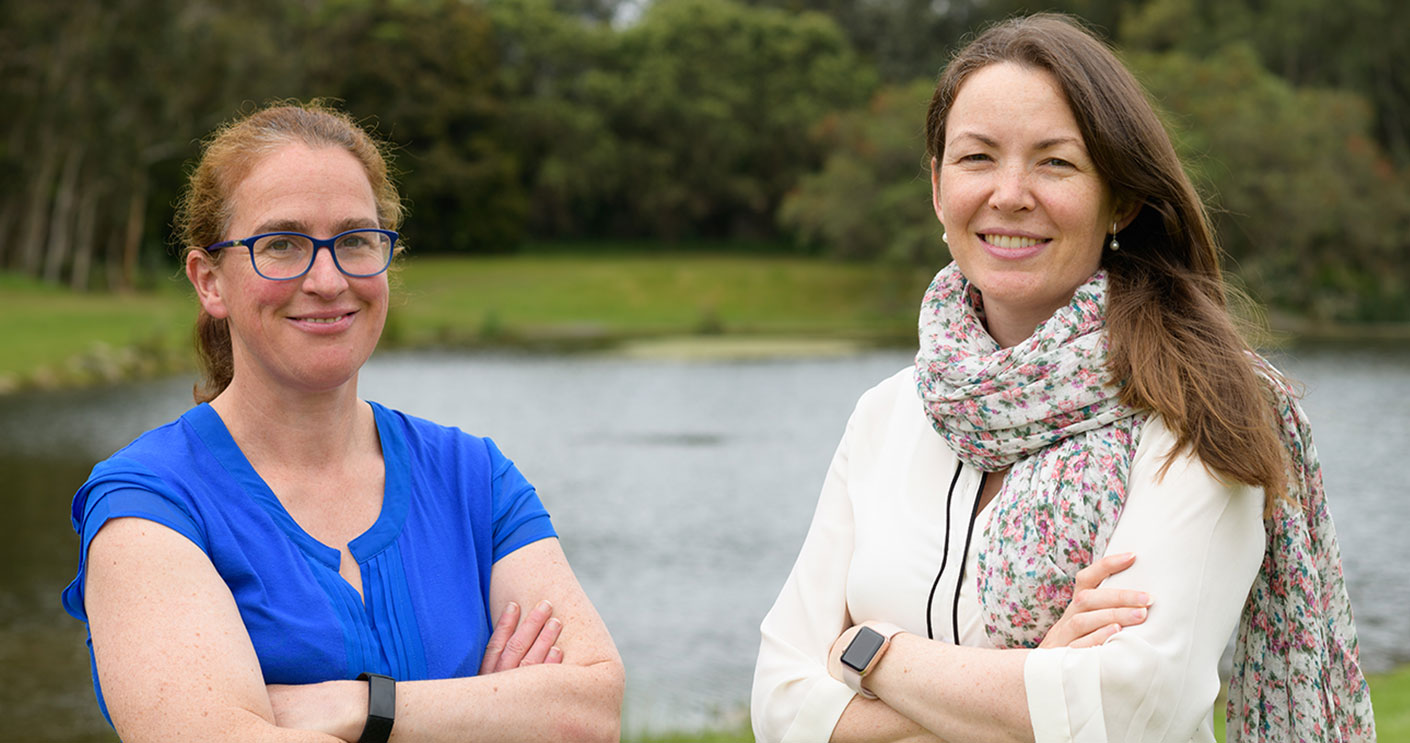Associate Professor Melanie Bishop (left) from the Department of Biological Sciences and Katherine Dafforn (right) from the Department of Earth and Environmental Sciences are tackling the urban sprawl into seas head on through the BioShelters project.
What real world challenge are you trying to address?
We’re looking at how ecological knowledge can improve the design and construction of marine urban structures, so as to ‘green the grey’.
Increasingly urban development is sprawling into the sea. As compared to the natural habitats they replace, structures such as seawalls, breakwaters, piers, pontoons and pilings typically support reduced biodiversity and fewer ecosystem services, such as fisheries productivity, maintenance of clean water and carbon sequestration.
Our research is investigating how the design of these structures can be modified such that they not only serve their primary intended purpose, but also provide habitat to marine plants and animals that are ecologically and functionally important.
How are you doing it?
The Bioshelters project lies at the intersection of ecology, sustainability, architecture, materials science, design and engineering.
We have been addressing the greening of marine urban structures from two angles:
- how can we mimic those habitat features of natural shorelines, that are missing from marine urban structures; and
- how can we design new ‘homes’ for marine plants and animals from first-principles, given site characteristics such as the availability of light, water quality, temperature and salinity.
The former comes more from an ecological perspective and the latter from an architectural perspective. Seeing when, and where, these two approaches converge and diverge has been really fascinating!
Who are your key collaborators?
The program runs out of the Sydney Institute of Marine Sciences (SIMS), of which Macquarie University is a founding member. Under the SIMS umbrella, we actively collaborate with researchers from UNSW on greening of marine urban seascapes.
The success of our research program is also in large part due to the commitment of Alex Goad, an industrial designer at the Melbourne-based SME, Reef Design Lab. His generosity of time and creativity has been integral to bringing our ideas to life.
Within Macquarie University, Distinguished Professor Lesley Hughes has been a huge source of support and inspiration in showing how science can be translated into action, and in thinking beyond the box on topics such as conservation and ecological restoration.
Have you received any external funding?
As well as funding through Landcom, donations from philanthropists (through the Harding Miller Foundation, Lim Sutton Initiative, Kirby Foundation), supported much of the initial research and development.
The subsequent scaling up of technologies to real world interventions, and the monitoring and evaluation of their efficacy has come from state and federal government sources, such as the NSW Environmental Trust and NSW Recreational Fishing Trust. Commercial sales have also provided funding for new research and development.
Any commercial innovations or spin-offs?
As part of our program we have developed Living Seawalls panels that can be fitted to marine urban structures such as seawalls to enhance their habitat value.
Living Seawalls: Bringing Sydney’s seawalls to life! from SIMS on Vimeo.
We have already had several commercial sales of this product in Australia, including for an upcoming installation at Watermans Cove Barangaroo. Internationally, we have had sales from as far away as Gibraltar. We have a number of additional products in the pipeline for development.
While it has been very gratifying to see our research directly applied to management, commercialisation has also brought challenges. For example, the possibility that our products may be used for greenwashing is one conundrum we have had to consider and combat.
What’s the ultimate goal?
Our vision is to transform urban waterways into biodiversity hotspots, that are of high environmental, social and economic value.
The COVID lockdowns have shown just how highly Australians value our marine ecosystems, for solace and recreation. Ensuring that our coastal cities can continue to grow sustainably is therefore a key goal of our research.
We have shown how seawalls can be modified to support greater biodiversity and ecosystem function, but we would now like to identify how similar approaches can be applied to other marine urban structures and be most effectively applied alongside conservation and rehabilitation of natural habitats.
We have a dream that no future marine construction will proceed without first considering opportunities for sustainability below the waterline and multiple benefits.


 Back to homepage
Back to homepage
Comments
We encourage active and constructive debate through our comments section, but please remain respectful. Your first and last name will be published alongside your comment.
Comments will not be pre-moderated but any comments deemed to be offensive, obscene, intimidating, discriminatory or defamatory will be removed and further action may be taken where such conduct breaches University policy or standards. Please keep in mind that This Week is a public site and comments should not contain information that is confidential or commercial in confidence.